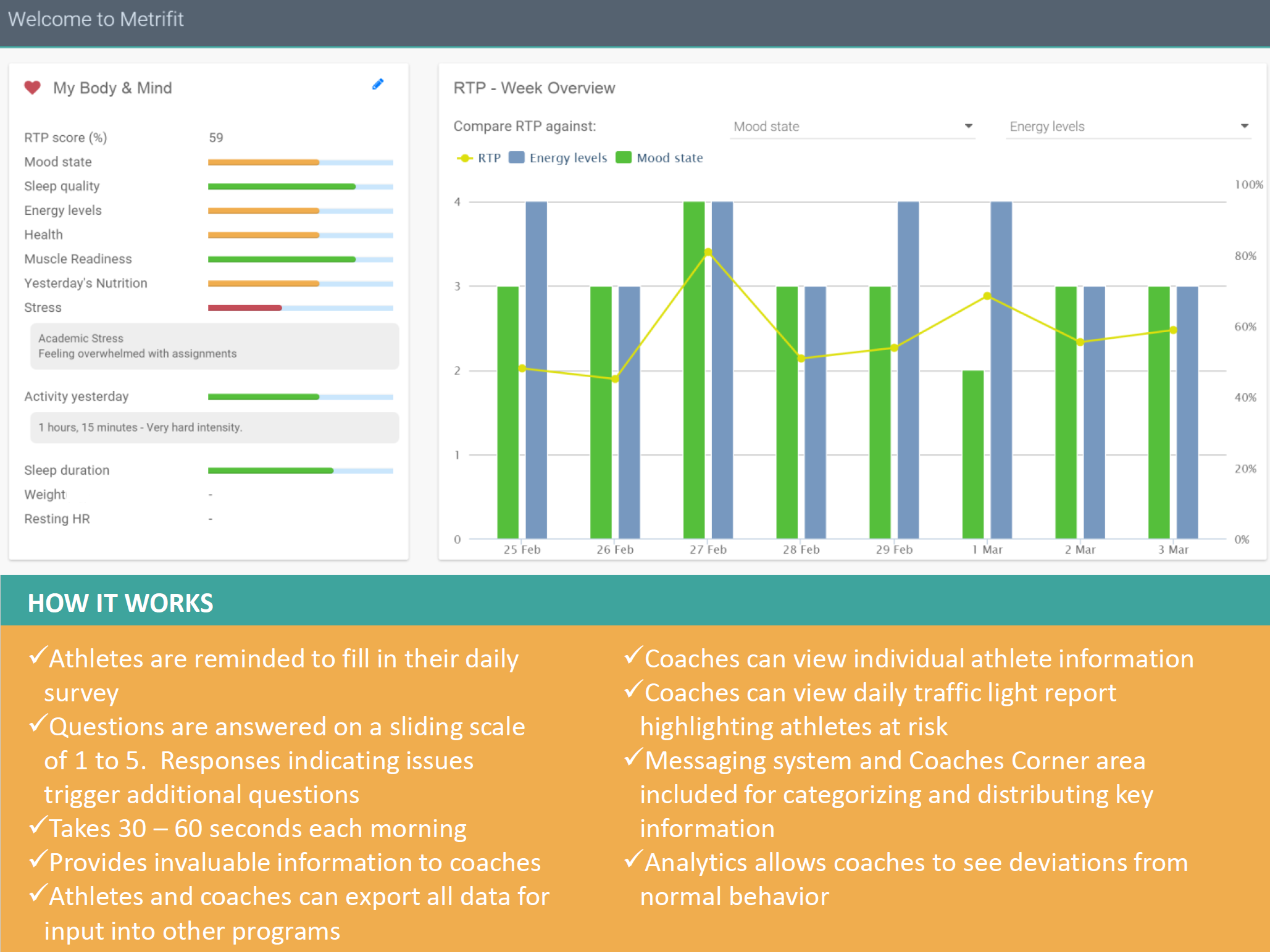Challenges to Effective Athlete Monitoring are Easily Overcome

This article first appeared in the SimpliFaster blog.
Achieving success in sport, particularly at the elite level, is a complex process. The days of natural talent representing the most important factor in being successful are long gone. In a modern world where sport is a billion-dollar business, there are many elements required to ensure an athlete achieves their dream.
Among the factors playing a role in turning potential talent into success are:
- Effective Coaching
- Desire
- Mental Strength
- Preparation and Recovery
Because these factors influence athletic training and performance, it is essential for the coaches and athletes to be aware of the extent of their impact. This desire has led to a huge focus on the area of athlete monitoring. In this article, we’ll look at this concept of monitoring and its impact on modern sport. We’ll look at why monitoring is necessary and the benefits it can bring as well as its potential challenges. We will also outline how the Metrifit system addresses these challenges and provides a platform that is straightforward, effective, and informative. Metrifit will help improve performance, for both teams and individuals, and hopefully prove to be the difference when it comes to achieving success.
Monitoring is Essential to Achieve Success
The benefits of monitoring are so plentiful, it’s hard to understand a time when it was not a significant portion of an athlete’s training program. Quite simply, monitoring improves an athlete’s performance through a combination of several factors. Monitoring an athlete’s training program helps ensure they are in the best possible condition to train. This, in turn, leads to a competitive edge. Monitoring gives coaches the opportunity to construct individualized training programs and optimize the prescription of training load and recovery. Aside from ensuring an athlete is following a suitable training program, monitoring assists in identifying such potential problems as injury, illness, and burnout. Each of these factors can hamper an athlete’s ability to train consistently. If they can avoid missing training sessions, they will be better prepared to achieve success. Monitoring also develops an athlete’s self-awareness and accountability, giving them a greater sense of responsibility for their well-being. With access to relevant data, the athlete has a greater understanding of how their own body functions. Consequently, they have increased focus to follow the correct program and a greater sense of motivation and confidence.
What Should an Athlete Monitor?
Next, we need to identify the areas in an athlete’s program that should be monitored to improve overall well-being and performance. This idea is highlighted in Monitoring Athletes, Taking Advantage of Technology which underlines the requirement that the information gathered must be relevant:
The first question that the coach needs to consider is what factors should be monitored. The question should identify the difference between what is ‘nice to know’ information versus what is ‘need to know’ information. Ideally the factors are scientifically validated to result in either enhanced training adaptation or performance outcomes directly. In other words, factors that result in confident actionable outcomes

Metrifit’s approach not only covers the physical requirements of a particular sport but also helps the coach derive the benefits of other factors that have a significant influence on an athlete’s well-being: training, body, nutrition, mind, and sleep.
Training
The value of monitoring athletes has been discussed at length in recent years. Perhaps Vernon Gambetta sums it up perfectly in the title of his recent article stating simply Monitoring Training is Critical for Success
Training is a repeating (rollover) process consisting of four steps: assessment, planning, implementation, and monitoring. Monitoring this process is essential to making the training meaningful and keeping it on track. The most effective training programs that I have seen and implemented are those that have a built-in monitoring system. It does not have to be anything elaborate or scientific. Whatever it is, it just needs to be used consistently
Body
One of the key elements of training and performing is ensuring that an athlete is in their best possible condition for performing. One of the most important factors in this regard is staying free from injury. Tim J Gabbett highlights this in his article Training-Injury Prevention Paradox when he states that there is a clear need to ensure that:
- athletes are following the correct training program
- athletes are training sufficiently to build up their physical capacities
- athletes are not doing too little training
Injuries are more likely to result from inappropriate training, Gabbett explains, and non-contact injuries are more likely caused by excessive and rapid increases in training. He argues that the way to deal with these problems is to monitor the athlete’s training program.
Nutrition
No matter how well a training regime prepares an athlete, they will never achieve optimum performance without proper nutrition. As everyone knows, a car will not run at its best unless it has a full tank of quality fuel. Likewise, an athlete’s body must be fueled correctly to reach their peak, as we are reminded in Nutrition and Hydration for Sports Performance
An adequate diet, in terms of quantity and quality, before, during and after training and competition will maximize performance. Without the correct nutritional support an athlete will not be able to sustain an intensive training programme over a long period of time, hence improvement will be limited
As a result, monitoring diet is essential to achieve the right balance of carbohydrates, proteins, fats, minerals, vitamins, and water to ensure athletes get the most from their training, can recover and, most important, produce their best when it comes to competition.
Mind
When competing for a top place at any level of sport, mental well-being is as significant as physical well-being. As a result, awareness of issues that could potentially add stress to an athlete is hugely important. Crucial factors with mental health issues are identification and early and effective intervention. Monitoring is vital in this regard. Brian Clarke, Head Strength and Conditioning Coordinator and Wellness Department Chair at Noblesville High School, Indiana found that using Metrifit monitoring during the past year provided X-ray vision into the habits/ lifestyles and stressors their athletes were experiencing on a day-to-day basis. Its importance can also go beyond athletic challenges
It offers shy or quiet students a voice they normally would not have the courage to have. I was able to identify some severe mental health concerns in two students this past year based off of consistent low Readiness to train scores and conversations with the students. It was literally a potential life-saver
Sleep
The importance of sleep to an athlete is significant in overall performance, and monitoring sleep patterns is now regarded as a must for athletes and coaches. The manual Sleep and Recovery explains the importance of sleep in terms of training, training effect, recovery, and performance with mental and physical sharpness directly linked to sleep
All sport requires the ability to process information very quickly and react. Athletes also need to have high levels of focus and motivation. These functions will be impaired without adequate sleep. Minimal sleep can also decrease glucose metabolism which fuels the brain and the body for mental and physical performance. Immune function can also be impaired which puts athletes at a greater risk for sickness. When athletes fail to sleep enough (less than 8 hours per night), the body fails to produce the adequate amount of testosterone
Challenges and Solutions to Effective Monitoring
Having established the benefits of monitoring and the specific areas that need to be monitored, the next issue is how to access to the specific information required to make a difference to an athlete. One of the biggest challenges to monitoring an athlete is creating a set of questions broad enough to collect the necessary information and not too complicated or time-consuming for the athlete to follow. Otherwise, it will be difficult for the athlete to buy-in to the system. In Monitoring the athlete training response: subjective self-reported measures trump commonly used objective measures: a systematic review Anna E. Saw, Luana C. Main, and Paul B. Gastin provide an overview of the main challenges to ensuring the appropriate questions are posed
These threats to validity have been attributed to cognitive and situational factors. Cognitive factors include miscomprehension and recall error, which may be addressed with clear instruction and minimizing the period of recall. Ensuring understanding of the overall task may also improve motivation to respond accurately, thus reducing conscious bias. Conscious bias is often the result of an individual responding in a socially desirable manner, generally over-reporting favorable responses and under-reporting unfavorable responses. In the sports setting, this may mean athletes ‘faking good’ to appear to be coping or to gain selection, or ‘faking bad’ to have their training reduced. Therefore it is important to not only consider the design of a self-report measure, but also the individual and situational factors which may influence the ability to obtain meaningful, accurate and consistent data from athletes.
It is clear to see that this information is of vital importance in preparing an athlete and the key to discovering such crucial data is clearly in the design of the questions and the structure of the survey to make it as easy as possible for the athlete to provide accurate information
Ensuring that athletes enter genuinely accurate information is one of the main challenges to a monitoring program. It is a question that initially concerns some of our clients. In reality, it is not an issue. In fact, not only do athletes buy-in to the system, they take on greater responsibility and ownership. A monitoring system also creates a strong relationship between athlete and coach. There may be concern that an athlete will log inaccurate information, particularly student athletes. A coach who is on top of his game and familiar with his athlete, however, can quickly identify this by comparing scores to performance. By encouraging ownership, students and coaches equally share in the athlete/team development process. This leads to a strengthening of the relationship between coach and athlete which also contributes to improving performance.
Some coaches fear that the process is too complicated and time consuming and, as a result, will prove counterproductive and interfere with training time.
The key is to use clear and relevant questions with a range of response options that are easily understood, allowing for swift and accurate inputs. A recent Metrifit Webinar illustrates how straightforward logging information is very and how an athlete can do it on a cell phone in seconds. This information becomes instantly accessible to the coach. Cian O’Neill, Kildare Senior Football Manager puts it simply:-
We are very lucky we have a player-monitoring tool, whereby players can communicate with you every day via psychometric data; sleep quality, sleep duration, stress levels, muscle soreness. What that means is by 11 am every day I have valuable pieces of information relating to every member of the squad
The final major challenge with implementing a monitoring system is making sure that we not only gather specific information that is useful but also that we use the information effectively in a training program to improve results.

Benefits for Coach and Athlete are Clear
As we can see, the value of monitoring all aspects of an athlete’s circumstances is essential if they are to realize their potential and perform at peak level on the occasion when it matters most. Monitoring athletes helps us learn their patterns of behavior and habits. Capturing that data allows coaches to evaluate the information and analyze it, which in turn helps them guide athletes to their best performance.
Vernon Gambetta sums up the process when he states:
Monitoring training allows you to reconcile what was planned for training and what was achieved. It is very specific to the sport, the performance level of the athlete, the age of the athlete, and the gender. Once a system of monitoring has been implemented, the information gathered must be straightforward and simple so that it can be easily interpreted and modifications can be made easily as needed
Analytics
Once a monitoring platform is successfully implemented, the next challenge is to get meaningful data into the hands and minds of the people who can make effective use of it. A central hub of data should become a funnel or platform to collate relevant key performance indicators. Insights from this data need to be visualized in such a way that they promote actionable intelligence. All the data in the world is useless if it’s not used to promote change and improvement.

Effective monitoring has many benefits for the athlete as the information gathered can be vital in preparing for the next step of the training program. Monitoring is only useful if it provides information or leads to practices that ultimately improve performance. Of course, there are challenges to ensuring the best possible outcome for athletes, and we have established how these obstacles are relatively easy to overcome. When that is achieved, the benefits for both coach and athlete are clear.
Metrifit Ticks all the Monitoring Boxes
Our latest product, Metrifit Ready to Perform (RTP), takes all this into consideration and, by providing feedback and analytics, aims to promote self-awareness and accountability on behalf of the athlete.

Metrifit RTP makes the monitoring technology of a professional team available on a new platform and at an affordable price. This is backed up by sophisticated descriptive analytics and intelligent feedback alerting coaches and athletes to any changes in behavior that may otherwise go unnoticed.

Our additional products, Metrifit Gold and Metrifit Elite, offer more complex monitoring and customizable features. For more information, please visit www.metrifit.com or contact us at or follow us on Twitter or Facebook
Please share so others may benefit.
References
Asking the right questions to assess athlete well-being
Metrifit helps to build the crucial athlete coach relationship
Metrifit provides x-ray vision into the lifestyle of the student athlete
Essential to keep track of factors that impact on performance
Monitoring sleep is invaluable for a coach
Session-RPE is an easy and effective method of monitoring training load
Athlete self-report measures
Study highlights the benefits of subjective self-reporting measures in training
The importance of relevant monitoring in training
The benefits of sleep for elite athletes
Monitoring training is critical for success By Vernon Gambetta
Monitoring the athlete training response: subjective self-reported measures trump commonly used objective measures: a systematic review by Anna E Saw, Luana C Main, and Paul B Gastin
Monitoring Athletes: Taking Advantage of Technology by David Hill
About Metrifit
Metrifit is an athlete monitoring system that gathers subjective and objective information from both coaches and athletes in a simple but effective manner with intelligent visualization helping coaches and athletes to act on that data. Why not have a look at our Ready to Perform product and gain insight on the physical and mental state of your athletes through our daily wellbeing questionnaire? To find out more visit our Metrifit Product Overview page or get in touch for a free demo.
































 Previous Post
Previous Post Next Post
Next Post





